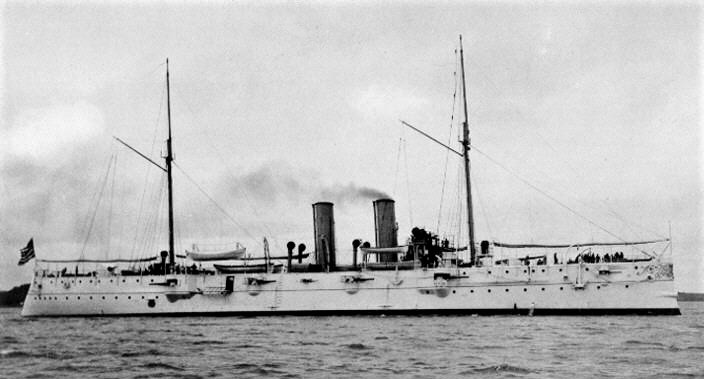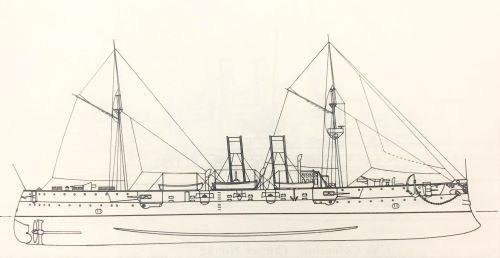

by Patrick McSherry

The Cruiser U.S.S. CINCINNATI (Source: Navsource)
The CINCINNATI was launched on November 10, 1892 by the New York City
Navy Yard. The vessel was commissioned on June 16, 1894 with Captain H.
E. Glass in command.
CINCINNATI's first cruise was to enforce neutrality laws,
specifically to stop the flow of arms, etc., between Florida and Cuba, where there were strong efforts
to aid the Cuban insurgents. The CINCINNATI served in this capacity in
1895 and 1896. Following this, the vessel served in the Mediterranean
from 1896 to 1897. With the sinking of the Battleship
MAINE and the approach of war, CINCINNATI joined the Cuban
blockade in April, 1898 and was also involved in the bombardment of
Matanzas, Cuba. By the end of May however, CINCINNATI was sent back
north to the U.S. for repairs. En route she escorted the Spanish prize
vessel, PANAMA as far north as Cape Hatteras where CINCINNATI entered
the navy yard at Norfolk. The CINCINNATI's machinery was
updated, her boilers retubed, her hull repaired, a mast was removed, and
her funnels increased in height by seven feet in an effort to increase
draft. She did not return to action until after the armistice was agreed
to between the U.S. and Spain, ending the war's fighting.
Subsequently, CINCINNATI was involved in transferring troops from
Guantanamo Bay, Cuba to Puerto Rico. She was also involved in a
reconnaissance of Culebra Island. Additionally, the CINCINNATI
was involved in the salvage of the of the lost Spanish naval vessels
following the Battle of Santiago. The vessel escorted the salvaged wreck
of the INFANTA MARIA TERESA which was being towed to Norfolk, Virginia.
Unfortunately, the vessels were caught in a storm, and the INFANTA MARIA
TERESA was lost again near Cat Island in the Bahamas. On December 17,
1898, as CINCINNATI was departing Santiago when she ran aground at full
speed, and it took forty hours for the collier SOUTHERY
and the gunboat MAYFLOWER to pull her free. On February, 14, 1899,
CINCINNATI was decommissioned at the New York City Navy Yard. Here the
vessel underwent extensive repairs.
CINCINNATI was recommissioned on December 2, 1901. In 1902 and 1903 the vessel operated in the Caribbean, and was involved in places such as Haiti, Santo Domingo, Panama and elsewhere. When Mt. Pelee erupted in Martinique, the CINCINNATI transported supplies to island. From 1903 to 1907, the vessel served in the Asiatic squadron. In 1907 the vessel returned to Mare Island Navy Yard in California where she was decommissioned on October 12, 1907. In 1911 the CINCINNATI was recommissioned, and was sent to serve in the Asiatic Squadron once again, remaining in that role until 1917, when she again returned to the United States. En route she delivered supplies to Guatemala following an earthquake in that country. She arrived at Hampton Roads, Virginia on January 16, 1918. From February, 1918 to March 1919, CINCINNATI served as the flagship of the American Patrol Detachment, protecting the movement of oil in the Gulf of Mexico.
CINCINNATI was decommissioned for the last time at New Orleans,
Louisiana on April 20, 1919. She was sold on August 4, 1921.
The vessel carried a full schooner sail rig, meaning that she was
not truly designed to be fully part of the modern steam navy. To man
the sails, she likely had to carry additional crew for that purpose.
The design of the CINCINNATI resulted in the ship being
over-powered, and the temperature in the confined spaces around the
powerplant rose to in excess of 200 degrees Fahrenheit. Ventilation
was inadequate and the engineering crew suffered greatly. The issue
would have been driven home in the heat of the waters off Cuba. It was
determined that these conditions would limit the vessel to only short
range operations. This decision was probably no surprise since so much
space was taken up with the machinery, the vessel's coal bunkers were
forced to be of a reduced size. This actually limited the cruising
range of the vessel regardless of the severely hot conditions
experienced by the crew. The cruising range of the CINCINNATI was
3,000 miles, which was short in comparison to other vessels of a
similar size.
The repairs done during the war were probably partially done in an
attempt to solve the heat issue. Following the war, the ship was
outfitted with a smaller powerplant to again help make the conditions
more livable, and increase the vessel's range.
The gun sponsons that protruded from the side of the ship would
have made coaling at sea difficult.

| Classification: | Protected Cruiser C-7, Cincinnati Class | |
| Keel Laid: | January, 1890 | |
|---|---|---|
| Launched: | November 10, 1892 | |
| Commissioned: | June 16, 1894 | |
| Rig: | Schooner | |
| Armament: | Ten 5-inch rapid-fire guns | |
| One 6-inch rapid fire guns | ||
| Eight 6-pounder rapid fire guns |
||
| Two 1-pounder rapid-fire guns | ||
| Two Colt machine gun | ||
| One rapid fire field gun | ||
| 1 Field Gun |
||
| 2 Whitehead torpedo tubes | ||
| Contractor: | U.S. Navy Yard, Brooklyn, NY | |
| Armor |
2 1/2" steel (slopes) |
|
| 1" steel (flat) |
||
| Cost: |
$1,100,000 |
|
| Length: | 300 feet | |
| Beam: | 42 feet | |
| Mean draft: | 18 feet | |
| Max. draft fully loaded: | 20 feet, 2-1/8" inches | |
| Displacement: | 3,213 tons | |
| Complement: | 20 Officers and 294 enlisted men | |
| Engine type: | Vertical triple expansion engines, generating 10,000 hp.; Twin screws | |
| Boiler type: | Four double-ended and two single-ended cylindrical boilers | |
| Speed: | 19 knots | |
| Coal bunker capacity: | 480 tons | |
| Endurance @ 10 knots: | 3,000 nautical miles |
Below is a list of officers, sailors and Marines assigned to the U.S.S. CINCINNATI
Alden, John D., The American Steel Navy. (Annapolis: Naval Institute Press, 1972) 55, 373.
Clerk of Joint Committee on Printing, The Abridgement of Message from the President of the United States to the Two Houses of Congress. (Washington: Government Printing Office, 1899). Vol. 2 1180-1183, 1248-1249.
"Cruiser Cincinnati," Fall River Daily Herald (Fall River,
Massachusetts). July 12, 1898, p. 1.
Dictionary of American Naval Fighting Ships.
Vol.2 (Washington: Naval Department, 1963), 119.
"Stuck on a Rock," Arizona Republic
(Phoenix, Arizona), December 19, 1898, p. 1.
"The Cruiser Cincinnati," Baltimore Sun
(Baltimore, MD), June 4, 1898, p. 2.
"The Cruiser Cincinnati Floated," Elk Creek
Herald (Elk Creek, Nebraska). December 29, 1898, 2.